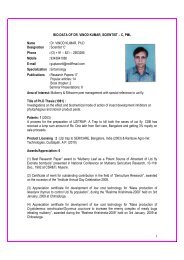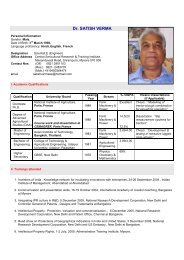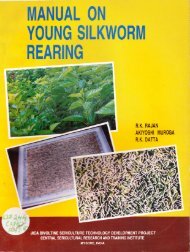Silkworm
A Treatise on the Acid Treatment of Silkworm Eggs - Central ...
A Treatise on the Acid Treatment of Silkworm Eggs - Central ...
Create successful ePaper yourself
Turn your PDF publications into a flip-book with our unique Google optimized e-Paper software.
a. Glycogen Conversion<br />
At the onset of diapause, in Bombyx eggs, glycogen is reported to decrease rapidly as it is converted<br />
into sorbitol and glycerolwhich are basically anti-freeze in nalure, (they increase the super-cooling ability,<br />
provide energy at diapause termination and stabilize the different enzymes even at low temperature).<br />
About B0% of the glycogen is converted into sorbitolduring the first 10 days after oviposition whereas<br />
glycerol gets accumulated during the later stages of diapause. At the termination of diapause, these<br />
polyols are reconverted into a glycogen store, that is to be utilized by the developing embryo, as an energy<br />
source.<br />
b. Changes in Glycogen Phosphorytase-A<br />
Glycogen Phosphorylase'a' is known to play a key role in glycogen metaboloism. lt is highly probabte<br />
that the key enzyme controlling polyolformation f rom glycogen at the initiation of diapause is Phosphorylase<br />
'a'.<br />
HCI treatment of diapause eggs of 20 hours age after oviposition blocks diapause initiation<br />
immediately andcauses a peculiartemporal increase in Phosphorylase'a'activity. Enzyme activity returns<br />
to its initial level in about 5 hours and remains as that in non-diapause eggs without any further increase.<br />
Someworkers have also presented the view that soaking of 24 hours old eggs in HCI solution causes<br />
complete inhibition olthe appearance ol lhe enzyme, glycogen Phosphorylase'a', activity at 50 hours after<br />
oviposition.<br />
HCI treatment while preventing the diapause phenomenon to occur also helps in retention of<br />
glycogen except for some insignificant conversion initially. The storage glycogen is consumed during the<br />
course of embryogenesis.<br />
c. Changes in Phosphofructokinase, Glucose-6-Phosphate Dehydrogenase and Fructose-1-6-<br />
Diphosphatase Enzyme Activities<br />
Glycolysis as well as pentose phosphate pathway are known to operate during the conversion of<br />
glycogen into glycerolon the initiation of diapause. Contrary to earlier reports, the activity of phosphofructokinase,<br />
a key enzyme of the glycolytic pathway, has been clearly demonstraled in prediapause, young<br />
diapause and developing eggs.<br />
Phosphofructokinase activity, in HCI activated eggs, is found clearly on the f irst day of development<br />
and increases gradually and reaches maximal levels in the later stages of development. The enzyme<br />
activity in young diapause eggs would be operating for glycogen conversion to glycerol in diapause<br />
initiation while in HCltreated developing eggs lor glycogen degradation involved in ATp production.<br />
Glucose-6-phosphate dehydrogenase activity in HCI activated eggs is maintained at higher level<br />
throughout the embryonic development and drops suddenly just before hatching. Fructose-1-6-<br />
diphosphatase enzyme activity is hardly observable by 5 days of embryonic development but thereafter<br />
rises abruptly until the hatching.<br />
CHANGES ASSOCIATED WITH LIPID METAEOLISM<br />
ln diapause eggs the lipid concentration in egg contents is about 68 to 70 mg per gram eggs<br />
throughout, from 2 hours to 40 days alter oviposition. On the other hand, in the HCI activated eggs, the<br />
lipid concentration decreases (68 to 32 mg/gm eggs), after oviposition until hatching especially in the later<br />
half of the development. lt is interesting to note that the lipid concentration in egg shell does not change<br />
significantly during diapause stage and in HCltreated eggs.<br />
Changes in pH levels<br />
The pH value ol the egg contents, alter HCltreatment, is lowerlhan that of the contents of untreated<br />
ones and this value also decreases with the duration of Hcltreatment.<br />
The results indicate that after HCI treatment the acid which permeates through the egg shells, brings<br />
about a change of the pH value in the egg contents.<br />
38




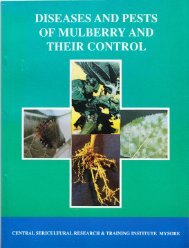

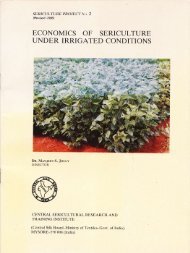
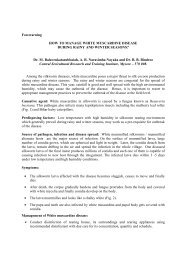
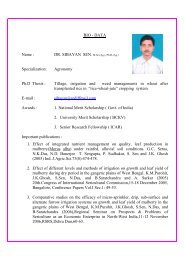
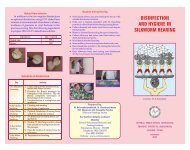
![E}A]\GALORE](https://img.yumpu.com/54052619/1/190x260/eagalore.jpg?quality=85)

